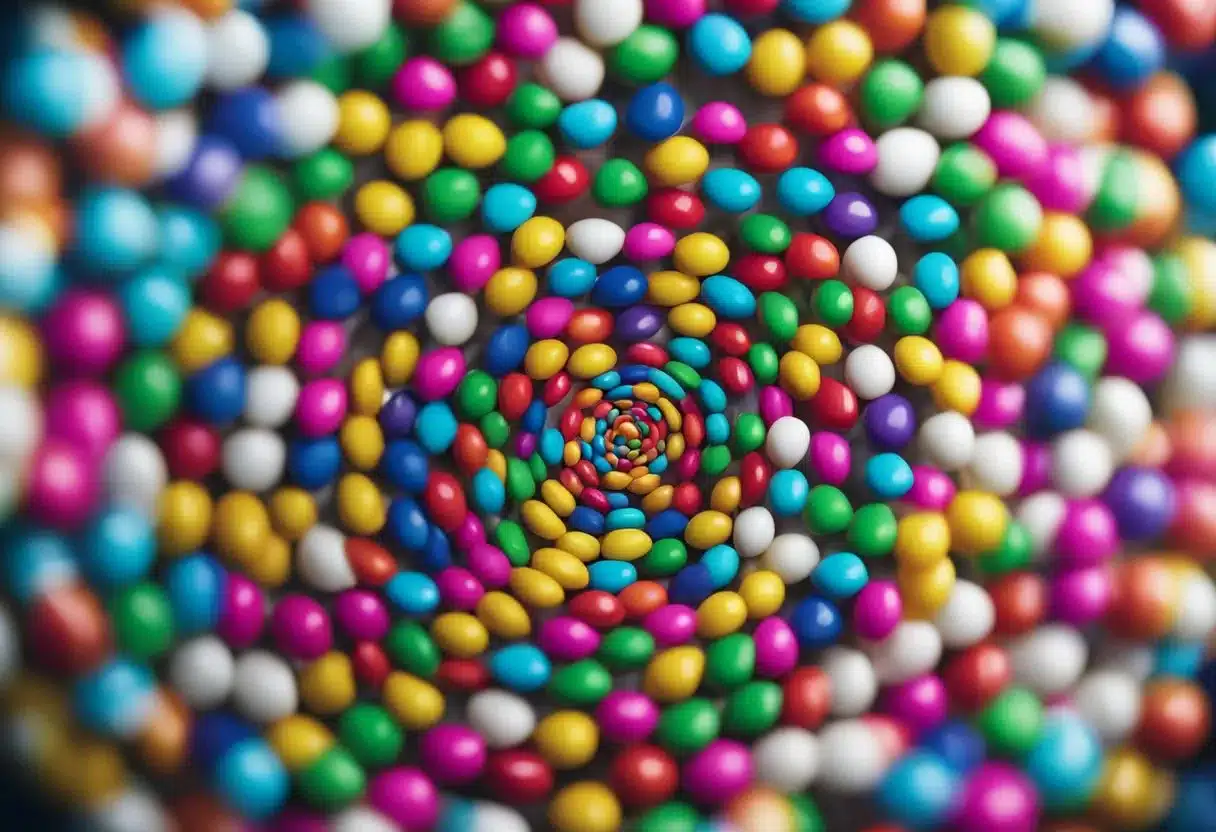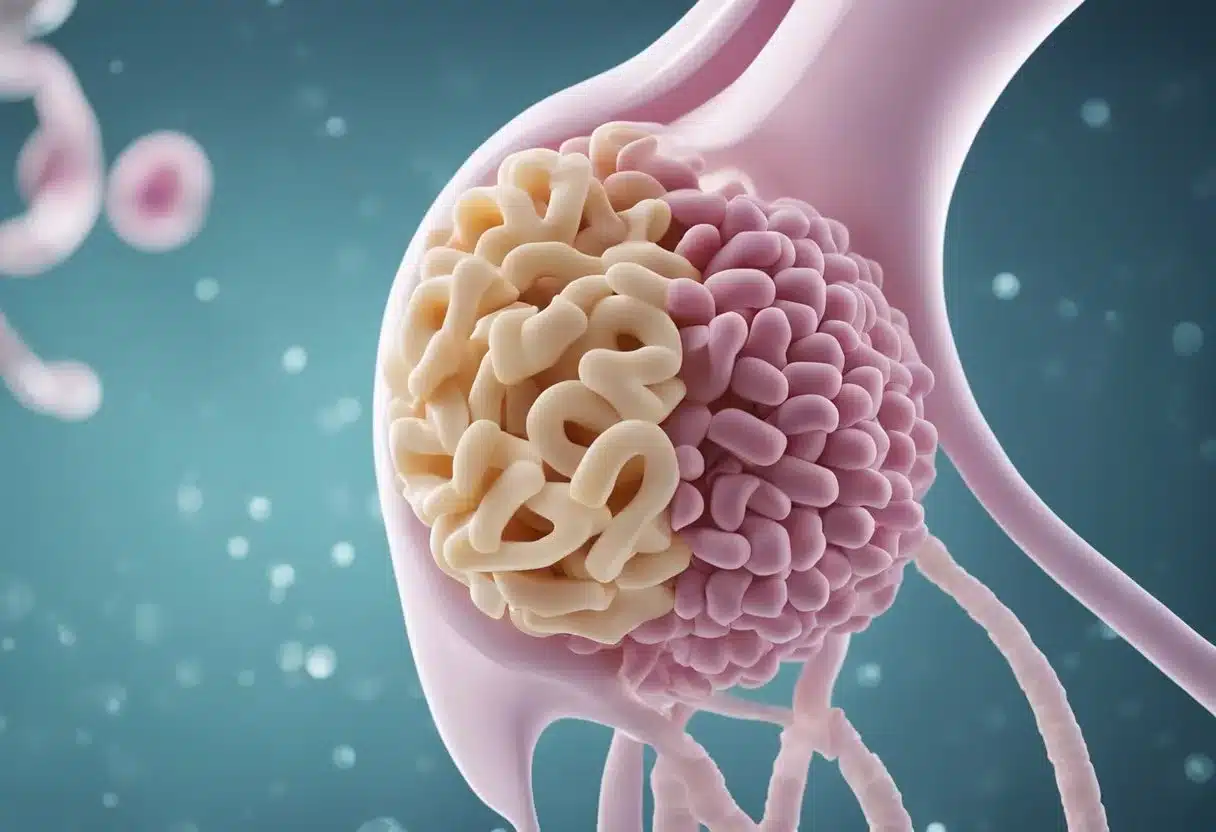Many people have heard the old saying that swallowed gum stays in your stomach for seven years. This myth has caused worry for gum chewers of all ages. But what really happens when you swallow gum?

The truth is, swallowed gum passes through your digestive system like most other foods. It doesn’t stick around for years or cause any major problems for most people. Your body can’t break down all parts of the gum, but it still moves through your system in a day or two.
Chewing gum is made of a gum base, sweeteners, and flavorings. The gum base is not digestible, which is why you can chew it for a long time without it dissolving in your mouth. When swallowed, this part of the gum stays intact as it travels through your digestive tract. The other ingredients get broken down normally.
Key Takeaways
- Swallowed gum passes through the digestive system in 1-2 days
- The gum base is not digestible but doesn’t harm most people
- Chewing and swallowing gum in moderation is generally safe
Gum Composition

Gum is made up of several key components that give it its unique properties. These ingredients work together to create the chewy, flavorful experience we associate with gum.
Ingredients and Properties
The main parts of gum are the gum base, sweeteners, and flavorings. Gum base is the non-digestible part that gives gum its chewy texture. It’s made from synthetic materials, resins, and waxes.
Sweeteners can be sugar or artificial sweeteners in sugar-free gum. Flavorings add taste and can be natural or artificial. Many gums also contain softeners and preservatives.
Here’s a breakdown of common gum ingredients:
- Gum base: 15-30%
- Sweeteners: 50-60%
- Softeners: 15-20%
- Flavorings: 1-5%
The Resilience of Gum Base
Gum base is what makes gum chewy and indigestible. It used to be made from chicle, sap from the sapodilla tree. Now it’s mostly synthetic polymers and resins.
These materials don’t break down in the digestive system. That’s why gum passes through the body largely intact. The gum base resists stomach acid and enzymes.
This resilience is what allows people to chew gum for long periods. It’s also why swallowed gum typically exits the body whole in a few days.
The Digestive Journey of Swallowed Gum

When you swallow gum, it travels through your digestive system much like other food. But gum is different because your body can’t break it down completely.
Gum’s Path Through the GI Tract
Swallowed gum starts its journey in the mouth and moves down the esophagus. It enters the stomach, where strong acids and enzymes try to break it down. Unlike most foods, gum resists digestion.
The gum then moves into the small intestine. Here, more digestive juices attempt to process it. But the gum’s base remains largely intact.
From the small intestine, the gum travels to the large intestine, also called the colon. It mixes with other undigested matter as it moves through.
Gum Interaction with Digestive Substances
In the stomach, hydrochloric acid and pepsin enzymes work on the gum. They can break down some ingredients like sweeteners and flavorings.
The gum base, however, is made of synthetic materials. These resist digestion. Bile from the liver and pancreatic juices in the small intestine have little effect on it.
As the gum moves through the GI tract, it may absorb water and other substances. This can cause it to change in size or texture slightly.
The Excretion Process
The undigested gum eventually reaches the end of the colon. Here, it becomes part of the stool. It passes out of the body in a bowel movement, usually within 40 hours of being swallowed.
For most people, this process happens without any problems. The body treats gum like other nondigestible materials it encounters.
In rare cases, swallowing large amounts of gum or swallowing it with other indigestible objects can cause issues. This might lead to intestinal blockage, especially in young children.
Potential Health Concerns

Swallowing gum can sometimes lead to health issues, especially for young children. While usually harmless, there are risks to be aware of and signs to watch for.
Risks to Children and Infants
Young children and infants face higher risks when swallowing gum. Their smaller digestive tracts make blockages more likely. Chewing gum is a choking hazard for kids under 5. It can get stuck in the throat or trachea, blocking air flow to the lungs.
The American Academy of Pediatrics advises against giving gum to young children. Parents should keep gum out of reach. If a child swallows a large amount of gum, watch for signs of trouble.
Teach older kids to spit out gum instead of swallowing. This helps form good habits and reduces risks as they grow.
Signs of Digestive Obstruction
Bowel obstruction is rare but possible when gum is swallowed often or in large amounts. Look out for these warning signs:
- Stomach pain or cramps
- Constipation
- Nausea or vomiting
- Bloating
- Loss of appetite
These symptoms may mean gum or other objects are stuck in the gut. The blockage can be serious if not treated quickly.
Adults who chew a lot of gum should be careful too. Swallowing gum regularly raises the chance of digestive issues over time.
When to Consult a Doctor
Most of the time, swallowed gum passes through without problems. But see a doctor if:
- Severe abdominal pain occurs
- Vomiting won’t stop
- No bowel movement for several days
- Signs of choking or trouble breathing
Emergency care is needed if someone is choking on gum. Call for help right away. In rare cases, surgery might be needed to remove a blockage caused by gum.
For kids, check with a pediatrician if you’re worried. They can check for problems and offer advice on prevention.
Addressing Common Misconceptions

Many myths surround swallowing gum. Let’s explore the truth behind these beliefs and understand what really happens in our bodies.
The Seven-Year Myth
The idea that gum stays in your stomach for seven years is false. This myth likely started because gum can’t be broken down by the body’s digestive system.
In reality, gum passes through the digestive tract like other indigestible items. It moves through the stomach, small intestine, and out with other waste. This process usually takes 1-3 days.
The body can’t break down gum’s base, but it doesn’t mean gum gets stuck. Doctors confirm that occasional gum swallowing is harmless for most people.
Gum as a Dietary Hazard
Some worry that swallowing gum affects nutrition or causes weight gain. These concerns are mostly unfounded.
Gum has little nutritional value. It contains few calories and doesn’t interfere with nutrient absorption. Regular gum swallowing won’t cause weight gain or nutritional deficiencies.
However, excessive gum swallowing can be risky. Large amounts might form a mass in rare cases, potentially blocking the digestive tract. This is more likely in small children or people with digestive issues.
For most adults, occasional gum swallowing poses no dietary risks.
Realistic Expectations of Digestion
Understanding how the body handles gum can ease concerns about swallowing it.
The digestive system efficiently moves gum through, just like other indigestible items. Stomach acids and enzymes work on gum’s sugar and flavorings, but not its base.
Gum typically exits the body within 24-72 hours. It doesn’t stick to intestines or cause lasting harm. The body treats gum like other small, indigestible objects it encounters.
While it’s best not to swallow gum regularly, doing so occasionally is generally safe. The digestive system is well-equipped to handle these situations without issue.
Prevention and Best Practices
Swallowing gum can be avoided with proper education and habits. Parents, caregivers, and individuals can take steps to prevent accidental ingestion and promote safer alternatives.
Guidelines for Parents and Caregivers
Parents should teach kids not to swallow gum. Explain that gum is for chewing, not eating. Set a good example by not swallowing gum yourself.
Supervise young children when they chew gum. Don’t give gum to kids under 4 years old. They might not understand it’s not food.
Teach proper gum disposal. Show kids how to wrap used gum in paper and throw it away. Make it a fun habit to find a trash can when done chewing.
Healthy Alternatives to Gum
Consider sugar-free candies or mints instead of gum. These dissolve and don’t pose a choking risk.
Encourage crunchy fruits and veggies for a satisfying chew. Apples, carrots, and celery are great options. They’re full of fiber and nutrients.
Try chewable vitamin C tablets for a burst of flavor. They provide a similar mouth feel to gum with added health benefits.
For fresh breath, suggest sugar-free breath strips. They dissolve quickly and don’t leave anything to swallow.
Promoting Responsible Habits
Make gum chewing a mindful activity. Chew for a set time, then dispose of it properly. This helps create good habits.
Teach about oral health. Explain how gum can help clean teeth after meals when brushing isn’t possible.
Encourage drinking water while chewing gum. It helps wash away sugar and keeps the mouth moist.
Set rules for gum chewing. No gum during sports, sleeping, or other risky times. This reduces chances of accidental swallowing.
Choose sugar-free gum with xylitol. It’s better for teeth and may help prevent cavities.
Gum in Context: Environmental and Manufacturing Aspects
Chewing gum production and disposal have important environmental impacts. The ingredients and manufacturing processes of gum affect ecosystems, while improper disposal creates litter issues in many cities.
Gum Production and Environmental Impact
Gum base forms the chewy part of gum. It often contains synthetic rubber, waxes, and plastics. These materials come from petroleum, a non-renewable resource. Making gum base uses energy and creates pollution.
Some gum makers now use plant-based materials. These choices can reduce environmental harm. But most gum still relies on synthetic ingredients.
Gum production also needs sweeteners, flavors, and other additives. Growing these crops uses water and land. Processing them takes more energy.
Packaging is another concern. Gum often comes in plastic or foil wrappers. These add to plastic waste problems.
Gum Disposal Considerations
Chewed gum is hard to clean up. It sticks to sidewalks and other surfaces. Cities spend money to remove gum litter. London spends millions each year on gum cleanup.
Gum doesn’t break down easily. It can stay on streets for years. Birds and other animals might eat it by mistake. This can harm them.
Some places have tried special bins for gum. These bins recycle the gum into new products. But most gum still ends up as litter or in landfills.
Biodegradable gum is a new option. It breaks down faster than regular gum. This could help reduce long-term litter problems.
Frequently Asked Questions
Many people wonder about the effects of swallowing gum. Let’s address some common concerns about this topic.
Can swallowing gum lead to any medical complications?
Swallowing gum rarely causes problems. In most cases, it passes through the digestive system normally. However, swallowing large amounts of gum or gum with other objects could potentially cause blockages. These blockages might require medical attention.
Is it harmful to ingest gum on a daily basis?
Regular gum swallowing is not recommended. While occasional ingestion is usually harmless, frequent swallowing may increase the risk of digestive issues. It’s best to dispose of gum properly after chewing.
How does the body process gum when it’s swallowed?
The body cannot digest gum like other foods. Gum passes through the digestive system largely intact. It typically exits the body in a bowel movement within 40 hours of being swallowed.
Are there any risks to swallowing gum while pregnant?
There’s no specific evidence suggesting swallowing gum is harmful during pregnancy. However, it’s always best for pregnant women to be cautious. They should avoid excessive gum swallowing and consult their healthcare provider with any concerns.
What should be done if a child ingests chewing gum?
If a child swallows gum occasionally, there’s usually no need for concern. Parents should discourage this habit to prevent potential issues. If a child swallows a large amount of gum or shows signs of distress, it’s wise to consult a doctor.
How long does chewing gum typically take to decompose inside the body?
Gum doesn’t decompose in the body like other foods. It usually passes through the digestive system within a day or two. The myth that gum stays in the stomach for seven years is not true.